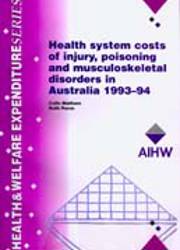Summary
Injury is the principal cause of death in people under 45 years of age, a leading cause of mortality, morbidity and permanent disability in Australia, as well as a major source of health costs. The direct health system costs of injury and poisoning amounted to $2,601
million in 1993–94, or 8.3% of total recurrent health expenditure.
Musculoskeletal disorders are not a major cause of death, but cause considerable morbidity and disability. Chronic musculoskeletal disorders are reported by 29% of Australians aged 15 years and over, and 56% of Australians aged 60 years and over. Musculoskeletal disorders were responsible for $3,002 million in health expenditure in 1993–94, higher than that for injury and poisoning, and only 20% lower than total health expenditure for cardiovascular diseases or for diseases of the digestive system. This report provides a systematic analysis of total health system costs of injuries, poisoning and musculoskeletal disorders in Australia in 1993–94.
The five external causes of injury that accounted for the most health expenditure in 1993–94,
in descending order, are:
- accidental falls $806 million (31% of total injury costs)
- adverse effects of medical treatment $401 million (16%)
- road traffic accidents $370 million (14%)
- homicide and violence $124 million (5%)
- suicide and self-inflicted injury $72 million (3%)
Adverse effects of medical treatment include medical and surgical misadventure and adverse reactions to drugs in theraupeutic use as defined by the International Classification of Diseases and as recorded in health system data collections.
Annual health system costs for injury are around $100 to $150 million for each 10 year age– sex group in adults, with the exception of men aged 15–34 where health system costs are two to three times higher, and women aged 75 years and over, where the $300 million
expenditure is mainly due to accidental falls. Together, accidental falls and adverse effects of medical treatment account for 90% of all injury costs for people aged 65 years and over.
Injury costs for males are around 20% higher than those for females on average, a much lower sex ratio than for deaths, where there are around 2.4 male deaths for every female death due to injury. The male to female cost ratio is highest for machine injuries, non-road transport accidents and homicide and violence, and is lowest for accidental falls, where costs for females are 40% higher than those for males.
Total health system costs of musculoskeletal disorders were $3,002 million in 1993–94. The five musculoskeletal disorders that accounted for the most health expenditure, in descending order, are:
- back problems $700 million (23% of total musculoskeletal costs)
- osteoarthritis $624 million (21%)
- muscle, tendon, soft tissue problems $519 million (17%)
- joint derangement and disorders $430 million (14%)
- neck problems $160 million (5%)
Total expenditure for musculoskeletal disorders rises during childhood and plateaus around $200 million dollars for each 10-year age group between ages 30 and 70. Health system costs rise steeply for older women to a total of $594 million for women aged 75 years and over, of which nearly 60% is due to nursing home costs. Per capita expenditure rises steadily with age to ages 65–74 years and then jumps substantially to around $600 and $1,000 per capita for men and women aged 75 years and over respectively. Costs of musculoskeletal disorders for females are around 38% higher than those for males, largely because of the high costs for older women.
Preliminary material (27K PDF): List of tables; List of figures; Preface; Acknowledgments
Introduction (27K PDF)
- Background and overview
- Uses of disease cost estimates
- Methodology
- Limitations
Health system costs of injuries and poisoning (65K PDF)
- Injury costs by type of injury
- Injury costs by external cause
- Injury costs and impact
- Injury costs by age and sex
- Most costly injuries at different ages
Health system costs of musculoskeletal disorders (50K PDF)
- Costs for specific musculoskeletal disorders
- Costs and impact of musculoskeletal disorders
- Musculoskeletal disorder costs by age and sex
Appendixes
Appendix A: Classification of disease and injury (36K PDF)
Appendix B: Summary of disease costing methodology (20K PDF)
Appendix C: Detailed tables - injury and poisoning, 1993-94 (75K PDF)
Appendix D: Detailed tables - musculoskeletal disorders, 1993-94 (65K PDF)
End matter: Glossary (22K PDF); References (7K PDF)



